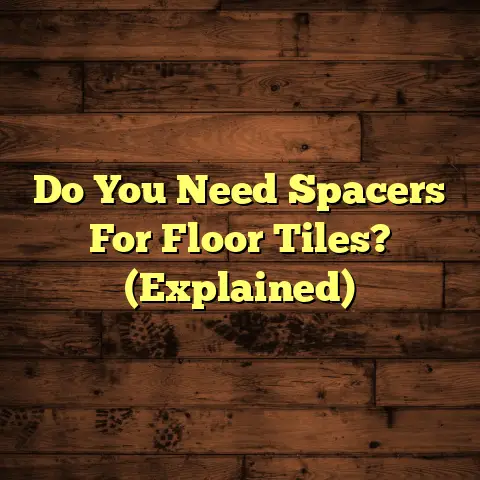How To Choose Engineered Hardwood Flooring Little Rock? (Explained)
When it comes to choosing engineered hardwood flooring, especially in Little Rock, there are numerous factors that come into play. Engineered hardwood is a popular choice due to its durability, aesthetic appeal, and versatility. Reflecting on my own experience, I remember when I first started researching flooring options for my home renovation. The variety of choices felt overwhelming at first, but once I broke down the information, I was able to make an informed decision that suited my needs.
What is Engineered Hardwood Flooring?
Engineered hardwood consists of multiple layers of wood, with a top layer made from real hardwood, giving it the beauty of solid wood while enhancing stability. The core layers are typically made from high-density fiberboard (HDF) or plywood, which helps resist warping and makes it suitable for various environments, including those with fluctuating humidity levels like Little Rock.
Construction of Engineered Hardwood
Understanding the construction of engineered hardwood is crucial. The typical structure includes:
- Top Layer: This is the visible layer made of real hardwood. It can be of various species such as oak, maple, or cherry. This layer determines the aesthetic appeal and can vary in thickness from 0.6mm to 6mm.
- Core Layers: The core usually consists of several layers of plywood or HDF that provide strength and stability. These layers are bonded together in different orientations to enhance durability.
- Backing Layer: Some engineered hardwoods feature a backing layer made from moisture-resistant materials to further protect against humidity.
Understanding the Specifications
When selecting engineered hardwood, it’s essential to look at technical specifications such as:
- Thickness: Most options range from 3/8 inch to 3/4 inch. Thicker planks generally offer better durability and can be sanded down if needed.
- Wear Layer: This is the top layer of hardwood that you see and walk on. A wear layer of 2mm or more is ideal for high-traffic areas. I learned this the hard way when I chose a product with a thin wear layer for my dining area; it showed scratches quickly.
- Core Material: The core affects stability. Plywood cores tend to perform better than HDF in humid conditions. During my research, I found that plywood cores provided better moisture resistance, which was essential for my home.
- Finish: Pre-finished options come with a protective coating that saves time on installation and enhances durability. I opted for a matte finish to avoid showing dirt and scratches easily.
Costs Involved
In terms of costs, engineered hardwood flooring in Little Rock can range from $3 to $14 per square foot, depending on the brand and quality. Installation costs typically add an extra $2 to $5 per square foot.
When I was budgeting for my project, I set aside around $3,000 for about 1,000 square feet of flooring, including both purchase and installation. Here’s a breakdown of the costs I encountered:
- Material Costs: For mid-range engineered hardwood at approximately $5 per square foot, I spent about $2,500.
- Installation Costs: Hiring professionals for installation cost me around $2 per square foot, totaling about $500.
- Additional Costs: I also had to budget for underlayment ($0.50 per square foot) and other supplies like adhesive and transition strips.
Installation Process
When it came time to install, I opted for a floating installation method. This approach allows the flooring to expand and contract without being nailed down, which is crucial in our humid climate.
Steps for Installation
- Preparation: Ensure the subfloor is clean and dry. I remember sweeping and vacuuming several times to ensure no debris would interfere with the installation.
- Acclimation: Before installation, I left the planks in the room where they would be installed for at least 48 hours to acclimate to the temperature and humidity levels.
- Underlayment: Lay down an appropriate underlayment that provides cushioning and sound absorption. This step is often overlooked, but it significantly impacts comfort and noise reduction.
- Plank Installation: Start from one corner and work your way across the room, clicking the planks together. I made sure to stagger the seams for a more natural look.
- Finishing Touches: After all planks were installed, I added transition strips at doorways and baseboards to give it a polished look.
I encountered some challenges during installation, especially in ensuring the planks fit snugly together without gaps. However, taking my time in measuring and cutting helped address this issue.
Maintenance Tips
Maintaining engineered hardwood is relatively simple but requires some attention to detail:
- Cleaning: Regular sweeping or vacuuming (without a beater bar) prevents dirt accumulation. I invested in a good quality microfiber mop that works wonders.
- Moisture Control: Use a damp mop instead of soaking the floor. This helps maintain the finish without causing damage. In Little Rock’s humid climate, I monitored indoor humidity levels to prevent warping.
- Refinishing: Depending on the thickness of the wear layer, you may be able to refinish engineered hardwood once or twice. My flooring has a 3mm wear layer, allowing for light refinishing in high-traffic areas after several years.
Advantages and Disadvantages
From my experience, here are some pros and cons of engineered hardwood flooring:
Advantages:
- Durability: More resistant to moisture than solid wood due to its multi-layer construction.
- Aesthetic Appeal: Available in many styles and finishes that suit various home designs.
- Installation Flexibility: Can be installed over various subfloors such as concrete or plywood without needing additional moisture barriers.
Disadvantages:
- Limited Refinishing: Unlike solid hardwood which can be sanded multiple times, engineered hardwood has a limited lifespan for refinishing due to its thinner wear layer.
- Cost Variability: While generally cheaper than solid wood, high-end options can still be pricey depending on the species and brand.
Practical Application and Usage
After installation, I quickly realized how versatile engineered hardwood could be in different rooms of my house:
Living Room
In my living room, the warm tones of oak created a cozy atmosphere. I placed area rugs strategically to protect high-traffic areas from wear.
Kitchen
Choosing engineered hardwood for my kitchen was initially nerve-wracking due to moisture concerns. However, I ensured proper sealing during installation and regularly wiped up spills immediately.
Bedrooms
For bedrooms, I selected a softer finish that adds warmth without being overly glossy. The underlayment helped keep noise down when my family moved around.
Environmental Considerations
In today’s world, sustainability is becoming increasingly important when making choices about home materials. Engineered hardwood can be more environmentally friendly than traditional solid wood because it uses less lumber per plank.
Sourcing Sustainable Options
I made sure to look for products that are certified by organizations like the Forest Stewardship Council (FSC), which ensures that the wood is sourced from responsibly managed forests.
Comparison with Other Flooring Types
I also looked into other flooring options like laminate and solid hardwood during my research phase.
Laminate Flooring
Laminate was less expensive but lacked the authenticity and warmth of real wood. It can mimic wood’s appearance but does not have the same tactile feel or longevity.
Solid Hardwood
Solid hardwood offered great longevity but required more extensive maintenance and was not as suitable for moisture-prone areas like my kitchen. Additionally, it can be challenging to install over existing flooring without raising the height of doorways.
Personal Experiences
Reflecting on my journey with flooring choices, I had both successes and challenges along the way:
Successful Choices
One of my best decisions was opting for a reputable local supplier in Little Rock who offered personalized advice based on my home’s unique conditions. Their expertise helped me select a product that balanced cost with quality.
Challenges Faced
A significant challenge arose when I underestimated the importance of underlayment; initially skipping it led to an echoing effect in my large living space. After realizing this issue, I quickly added underlayment beneath the existing flooring, which significantly improved comfort and sound absorption.
Future Considerations
Looking ahead, I plan to monitor how well my engineered hardwood holds up over time. As with any material choice, regular care and maintenance will be key in ensuring longevity.
Additionally, as trends shift toward sustainability and eco-friendliness, I am interested in exploring newer products made from recycled materials or sustainably sourced woods for any future renovations.
Conclusion
Choosing engineered hardwood flooring in Little Rock involves understanding your specific needs and preferences. From my own experience, weighing the advantages and disadvantages helped me make a more informed choice. Ultimately, I chose a mid-range product that balanced cost with quality, leading to a beautiful floor that has held up well over time.
For anyone considering this option, I recommend visiting local showrooms to see samples in person and consult with professionals who can provide insights based on regional conditions. By taking these steps and incorporating lessons learned from personal experiences, you can confidently select engineered hardwood flooring that meets your needs now and in the future.





